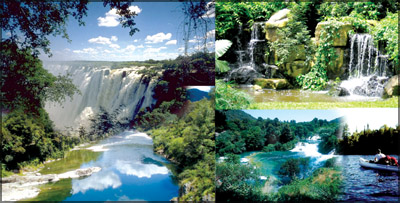Freshwater biome - most important to us
 In
our series on biomes, this week's topic is the freshwater biome. In
our series on biomes, this week's topic is the freshwater biome.
As you know, about three quarters of the Earth's surface is covered
by water. The water biome is divided into freshwater (water with little
salt in it, such as in ponds, rivers and streams and marine, or salt
water in oceans).
Ponds and lakes
A pond is a shallow hole where water accumulates (collects). Plants
generally grow around the edges of the pond, and often right across the
whole pond. The temperature of the water is similar at the surface and
at the bottom. The bottom is generally covered with mud. There are
usually no waves. In places where winters are very cold, the whole pond
can freeze solid. Some ponds are seasonal.
A lake is bigger than a pond, and could sometimes spread over
thousands of square metres. Plants can only grow along the shoreline, because of the depth of the water.
grow along the shoreline, because of the depth of the water.
Some lakes are so big that they give rise to waves too, an example is
the waves forming in the 'Parakramabahu Samudraya' in Polonnaruwa.
During the hot season, the temperature of the water at different
levels of the lake is not the same. The top part of the water gets more
of the Sun's heat and is therefore warmer. The middle layer is cooler
because it gets less of the sunlight, and the bottom layer, which does
not get any sunlight, is quite cold. Most creatures live in the warmer
water.
Even in the coldest places, most lakes are so big and deep that they
don't freeze solid during the winter season. However, a layer of ice can
form across the surface. The ice blocks out the sunlight, and oxygen
levels in the water drops, killing some of the plants and animals. This
is called 'winter kill.'
Lake Baikal, in central Asia, is the biggest lake on Earth. It
contains about one fifth of the Earth's freshwater and has a maximum
depth of 5,315 feet! Lake Tahoe is a huge lake on the border of
California and Nevada, USA, that originates from mountain stream
run-off.
Algae
In all freshwater around the world, algae can be found. Algae are not
plants, animals or fungi. They are simple organisms. Scientists place
most algae in the protist kingdom.
There are different kinds of algae, most are single celled, but some
have more than one cell. As they make their food through
photosynthesis,
algae release oxygen into the water. Photosynthesis uses sunlight as a
source of energy to combine carbon dioxide, water and salts to form
chlorophyll.
This means algae are most abundant during the hot season. Too much
algae also poses a problem. They can block out sunlight into the rest of
the water and could even lead to pollution.
Rivers and streams
Rivers and streams are moving bodies of water. Rivers are large and
flow into the ocean. Rivers and streams account for about three per cent
of the Earth's freshwater.
They drain the Earth of excess water. Precipitation may fall as rain,
hail, snow or sleet. Once it reaches the ground, some of the water is
absorbed by trees and other plants.
Water, which is not absorbed, filters down into the ground. Over
time, as rivers travel, they change course and carve a path through the
land. This causes
oxbow lakes, caverns and
canyons. The place where fresh and salt water meets is called an
'estuary (we featured
estuaries in an earlier issue). A unique place where two habitats come
together is called an ecotone.
Most water runs off the surface of the earth and eventually joins a
stream. Small streams join together to form rivers. Sometimes, small
rivers join together to become large rivers.
A watershed is an area
of land where rain water, streams and small rivers all drain into one
large area of water such as a large river, lake or ocean. Because ground
water also drains into watersheds, all kinds of pollutants can find
their way to the ocean from many kilometres away.
The biggest rivers have the biggest watersheds. Therefore, biomes
with lots of consistent rain have more rivers and streams. Deserts have
little rain and fewer rivers. Desert rain is short, but very intense.
So, dry rivers and lakes suddenly become full for a short period of
time.
Importance
Without freshwater biomes, people would not be alive. Freshwater
ecosystems are important because they provide us water for drinking,
energy and transportation, recreation like boating and fishing, and many
jobs. People use rivers to produce hydroelectric power.
Wetlands are also an important type of freshwater eco-system.
They may be soggy and stinky, but they provide critical habitat for
tons of plants and animals, help clean our water, control floods, and
provide food for humans. So, we have to conserve water, and be very
careful not to pollute water. We must be careful to preserve the biome
that is most important to us.
Compiled by Janani Amarasekara |
